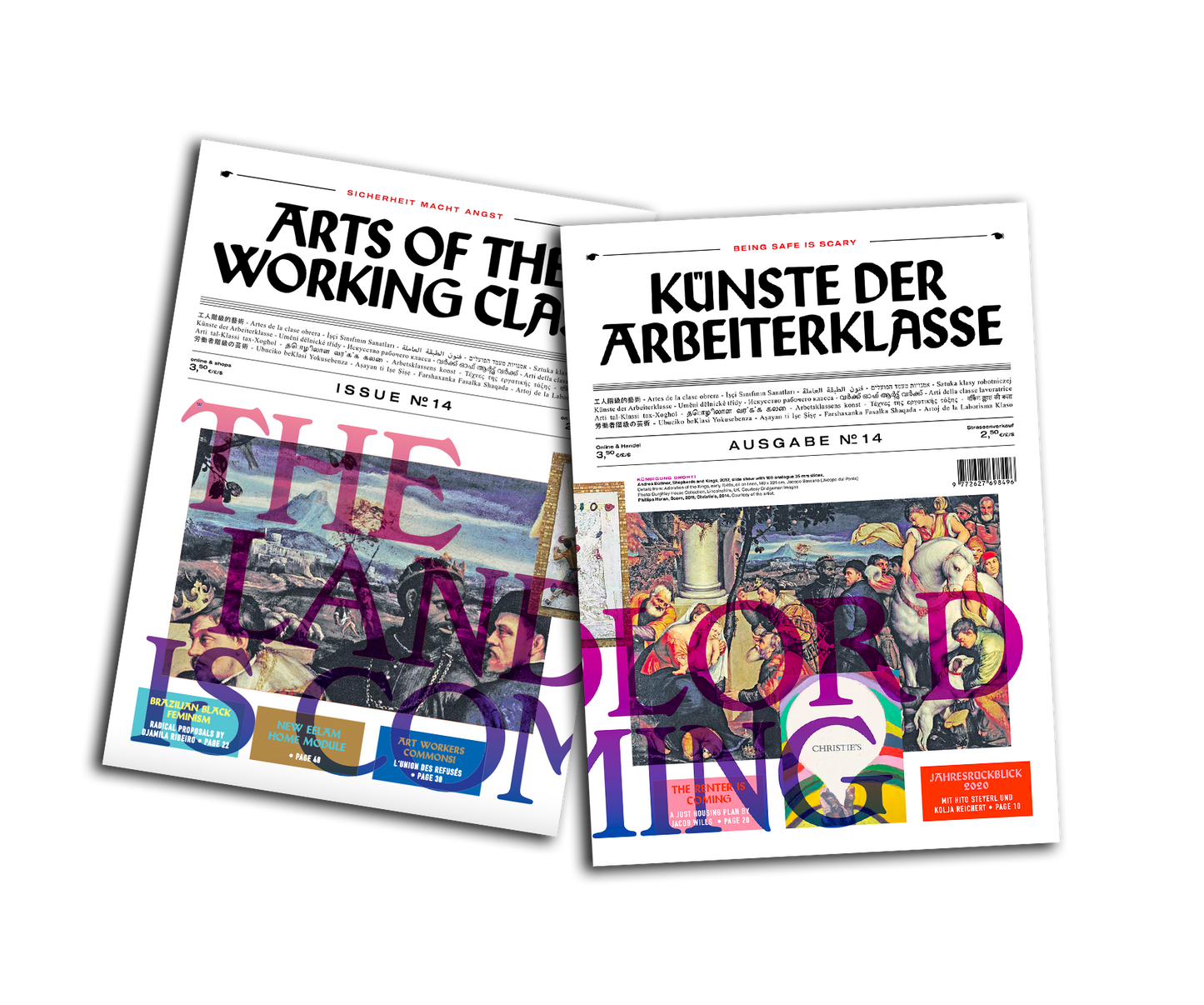Arts of the Working Class
ISSUE 14: Being Safe is Scary
ISSUE 14: Being Safe is Scary
Couldn't load pickup availability
Almost 80 million people worldwide are directly affected by forced displacement. Simultaneously cities are facing an unprecedented eviction crisis. The fear of displacement doesn't only affect residents of war zones. It is the ground (mostly European and American) on which radicalization, xenophobia and conspiracy theories are currently flourishing.
Art has long been an accomplice in the gentrification of cities and the resulting segmentation of society. How can art improve our lives, without selling our souls to the 1%? How can it provide autonomy and independence from investment schemes of the world’s landlords? How can we re-evaluate the wealth of the world and re-ignite our collective imagination?
When artist Banu Cennetoğlu declared ‘Being Safe is Scary’ in Germany, she not only paid tribute to the freedom fighter Gurbetelli Ersöz, who coined the term, but referred to Kassel's fascist past. The co-option of Germany’s oldest museums’ inscription activated the meme for this winter issue. “Sicherheit macht Angst”.
Denn von wessen Sicherheit sprechen wir?
Whose rights are protected, how does your personal shelter look like?
Together with advising editor Kolja Reichert, this issue looks at inner and outer landscapes created by politics, culture and society at large. Departing from the labor of art, the contributions go against the moral superiority as the new motor of argumentation seen in all media. While the uncertainty of our time accelerates, speculative communities, a concept of associate editor Aris Komporozos-Athanasiou, replace the fundamentals of togetherness. Revisiting these is the precondition of a more livable present.
Between the pandemic and class struggle (Hito Steyerl, Barbara Cassavecchia), the shame that comes with it (Andrea Büttner, Daniela Dröscher), housing and decoloniality (Suhail Malik, Guerrilla Architects), eviction and antiracism (Rifki Akbar Pratama, Zona Mista), gentrification and unions (Art Against Displacement, Jacob Wills, Union des Refuses, among other initiatives) we want to crack the riddle of why colonialism prevails as a priority of historical museums, why is discrimanation still a social phenomena based on shame and shaming (Mohammad Al-Hasani, Olga Grjsnowa - translated by Ayham Majid Agha).
History has proven that fighting for basic rights requires the unionization of an intersectional class discourse, no matter whether it is fair pay, gender and ethnical equality or the right for secure living and healthcare conditions. Models of community building from all over the world exemplify how resilient spaces for cultural work can thrive and persist in spite of real estate speculation.
Not only are (art) workers facing the landlord's looming presence, but also the power structures between communities and peers that make hostility and division possible. In this vein we’re introducing you, dear readers of the world, to the ‘Union des Refusés’:
This is a call to bring together smaller and larger initiatives, unions and structures of community building for the arts. A network of mutual care, in order to initiate something like an actual global union, different to a common trade union or chamber of commerce, turning it into a channel of communication – in the spirit of radical horizontality introduced with the Salon de Refusés by Napoleon, out of all people (well, a bit more radical maybe).
Art workers, way too long seen as entrepreneurs and system-slaves at the same time, have been left in a limbo of precarious conditions.
Arielle Azoulay, Jonas Tinius and Bonaventure Soh Bejeng Ndkung look at museums as crime scenes and an anonymous group of students shed light on further changes to be done in academia and institutions with anonymous networks of POC students in European cities. We close the year, tirelessly and grateful for all who believe in this publication, willing not only to thematize but act upon the redistribution of wealth for the well-being of (art) workers, the underpaid, unemployed, the lost and the privileged.
Enjoy this bouquet of exhaustive research and poetry, visually wrapped by the works of Andrea Büttner, Phillipa Horan and Willem de Rooij. They examine the symbolic value of the oppressed in the arts, in history and in economics. The greedy landlords of the world are only part of the operating system we need to smash. Renters are raging, evicted and houseless unite, a new leftist internationalism converts displacement into the power of belonging here, there, and everywhere.
Alina Kolar, María Inés Plaza Lazo & Pawel Sochacki
PUBLISHING ADDRESS / VERLAGSADRESSE:
Reflektor Monde gUG (haftungsbeschränkt), Lynarstrasse 38, 13353 Berlin
Vertreten durch die Geschäftsführer:
Alina Kolar, María Inés Plaza Lazo, Pauł Sochacki Advertisement / Anzeigen: hey@artsoftheworkingclass.org Founders / Gründerinnen: María Inés Plaza Lazo, Pauł Sochacki
Alle Vertriebs und Kundenanfragen an: Arts of the Working Class, Lynarstrass 38, 13353 Berlin, DE / E-mail: hey@artsoftheworkingclass.org / Tel: +49 1716292064
Publishers/Herausgeber*innen & Editors/Redakteur*innen:
Advising Editor: Kolja Reichert
Associate Editor: Aris Komporozos-Athanasiou
Managing Editor: Sebastjan Brank
Art Direction/Layout: Hans Löffler
Distribution & Content Management: Chris Paxton
Intern / Praktikant*innen: Kaya Haslinger
Druck: Druckzentrum
Osnabrück GmbH & Co. KG, Osnabrück, DE
Mit freundlicher Unterstützung der Stiftung Kunstfonds im Sonderförderprogramm 20/21 NEUSTART KULTUR




